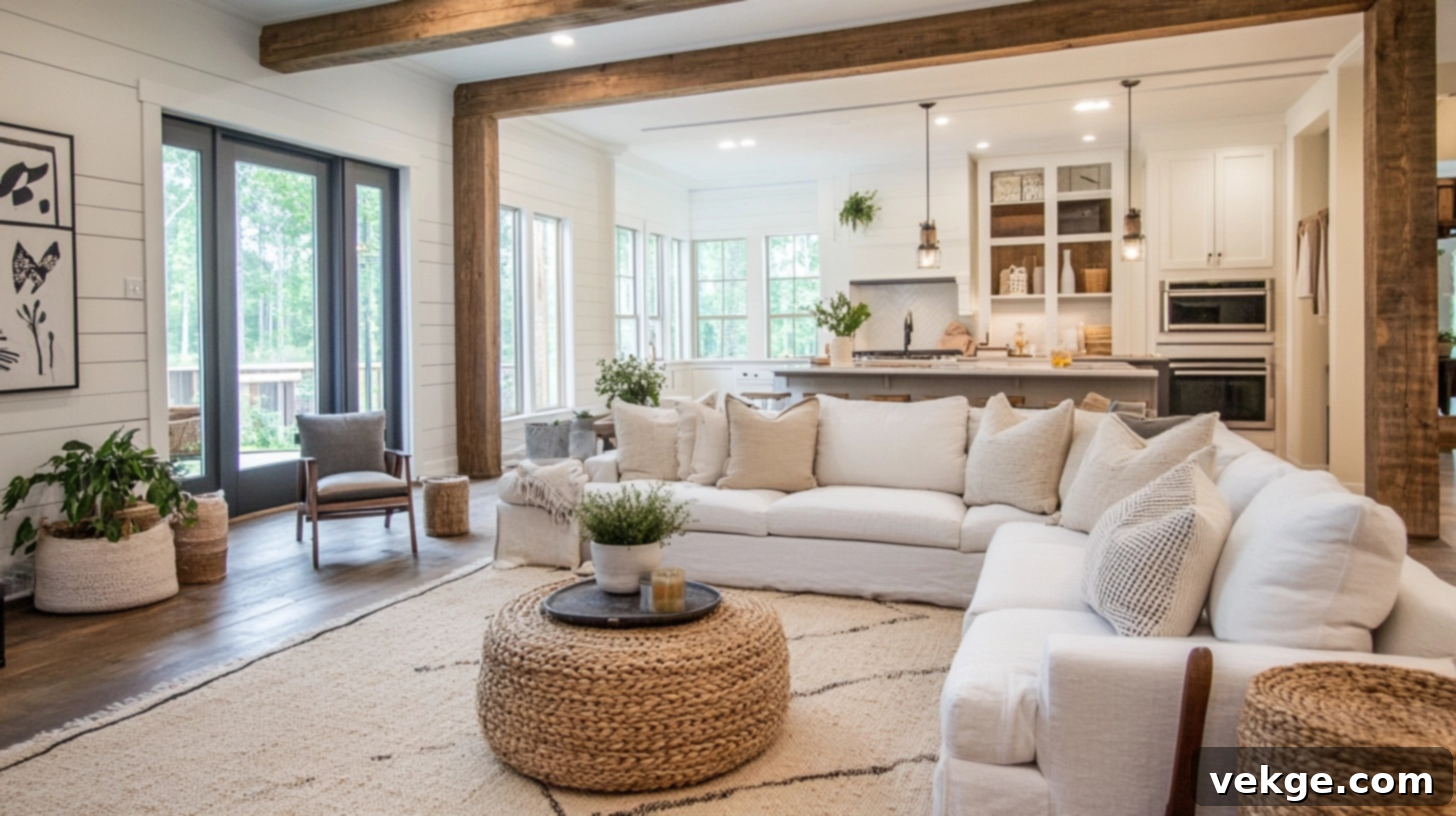Your Guide to a Fixer Upper Living Room: Rustic Charm Meets Modern Comfort
Imagine stepping into a living room that instantly feels inviting and full of character – a place where comfort reigns, but style is undeniable. This is the magic of the Fixer Upper aesthetic, a design philosophy that masterfully blends the charm of old-world treasures with the crisp simplicity of modern design. It’s a style that transcends fleeting trends, offering a timeless appeal that’s neither overly formal nor excessively rustic.
The essence of a Fixer Upper living room lies in its thoughtful curation: picture aged, textured wood surfaces living harmoniously with sleek, contemporary furniture; soft, neutral color palettes providing a serene backdrop for cherished antique finds; and well-loved pieces complementing clean lines. The result is a space that feels genuinely cozy and lived-in, yet impeccably organized and fresh. Best of all, achieving this sought-after look doesn’t require an enormous renovation budget or a team of designers. With a little creativity, strategic planning, and some elbow grease, you can infuse your living room with this beloved style.
In this comprehensive guide, we’ll dive deep into real-life, actionable ideas and DIY projects designed to help you transform your living room into a Fixer Upper haven. From impactful weekend projects to simple, cost-effective updates, we’ll cover everything you need to know. Get ready to discover inspiring design principles and practical tips to create a living space that truly reflects your personal style while embracing the enduring allure of farmhouse modern design.
Let’s unlock the potential of your living room!
Understanding the Fixer Upper Living Room Aesthetic
At its heart, a “Fixer Upper” living room is more than just a decorative style; it’s a feeling. It represents a transformation, often taking spaces that were once overlooked or outdated and breathing new life into them. These are rooms where class effortlessly meets function, creating warm, welcoming environments that feel simultaneously fresh, current, and deeply rooted in timeless design principles. It’s about creating an atmosphere that invites relaxation, encourages gathering, and reflects a sense of history and comfort.
The Enduring Appeal of Joanna Gaines’ Signature Style
When most people think of the Fixer Upper style, the iconic touch of Joanna Gaines immediately comes to mind. Her influence has made this aesthetic incredibly popular, inspiring countless homeowners to replicate its charm in their own living rooms. Gaines’ designs are celebrated for their ability to blend rustic elements with refined touches, making every space feel thoughtfully designed yet entirely approachable. Let’s break down the key components of her signature living room look:
- Shiplap Walls: A cornerstone of the Gaines’ aesthetic, shiplap isn’t just a wall treatment; it’s a statement. These horizontal or vertical wooden planks instantly add architectural interest, texture, and a touch of farmhouse charm, transforming plain walls into focal points. It creates a subtle visual rhythm and a sense of history that makes a room feel more grounded.
- Embrace of Natural Wood: From majestic ceiling beams and wide-plank flooring to handcrafted furniture pieces, natural wood is paramount. Gaines utilizes wood in varying tones, typically leaning towards warmer, lighter finishes, to inject warmth, authenticity, and an organic feel into every corner of the living room. It grounds the space and connects it to nature.
- Masterful Texture Mixing: Rather than relying on bold patterns, Gaines achieves visual richness through a sophisticated interplay of textures. This includes plush, inviting rugs that add softness underfoot, crisp linen or smooth cotton fabrics on upholstery, the tactile appeal of raw or distressed wood, and the intricate detail of woven baskets or decor items. This layering creates depth and comfort without overwhelming the eye.
- Simple, Soothing Color Palettes: The foundation of a Fixer Upper living room almost always begins with a serene, neutral color scheme. Whites, creams, warm grays, and soft beiges dominate the walls and larger furniture pieces, providing a calm and expansive canvas. This deliberate restraint allows smaller, carefully chosen pops of color – perhaps in throw pillows, artwork, or fresh greenery – to truly shine and be easily updated with the seasons.
The Perfect Blend: Farmhouse Charm with Modern Sophistication
The true genius of the Fixer Upper style lies in its artful fusion of two seemingly disparate aesthetics: the comforting, nostalgic appeal of rustic farmhouse living and the sleek, uncluttered elegance of modern design. This harmonious balance creates living rooms that are not only deeply inviting but also undeniably chic and relevant for today’s homes. It’s about achieving a lived-in feel without sacrificing sophistication.
To master this blend, consider these elements:
- Rustic Foundation: Start with foundational elements that evoke a sense of history and rural charm. Think exposed wooden beams overhead, a grand stone or brick fireplace that serves as a natural focal point, or wide-plank floors with a slightly distressed finish. These elements inject warmth, character, and a connection to traditional craftsmanship.
- Modern Refinements: Counterbalance the rustic with contemporary choices. Select furniture pieces that boast simple silhouettes, clean lines, and minimal ornamentation. Sofas, armchairs, and coffee tables with a modern profile prevent the room from feeling overly heavy or dated. Incorporate sleek metal accents, glass elements, or understated lighting fixtures to introduce a fresh, current appeal.
- Unifying Neutral Palette: The bridge between these two styles is almost always a carefully chosen neutral color palette. Shades of white, cream, warm gray, and soft beige act as a cohesive backdrop, allowing both rustic and modern elements to coexist gracefully. This serene foundation ensures that the space feels balanced, current, and capable of enduring various decorating updates over time.
This dynamic interplay ensures that your living room feels both comfortably established and stylishly contemporary, offering the best of both worlds without feeling disjointed.
Inspiring Fixer Upper Living Room Ideas to Transform Your Home
Ready to infuse your home with that sought-after Fixer Upper charm? Here, we’ve curated a collection of inspiring living room ideas, complete with practical tips and actionable advice. These transformations range from simple weekend DIYs to more significant upgrades, all designed to help you create a living space that feels both fresh and classically inviting.
1. Shiplap Accent Walls: Adding Texture and Timeless Character
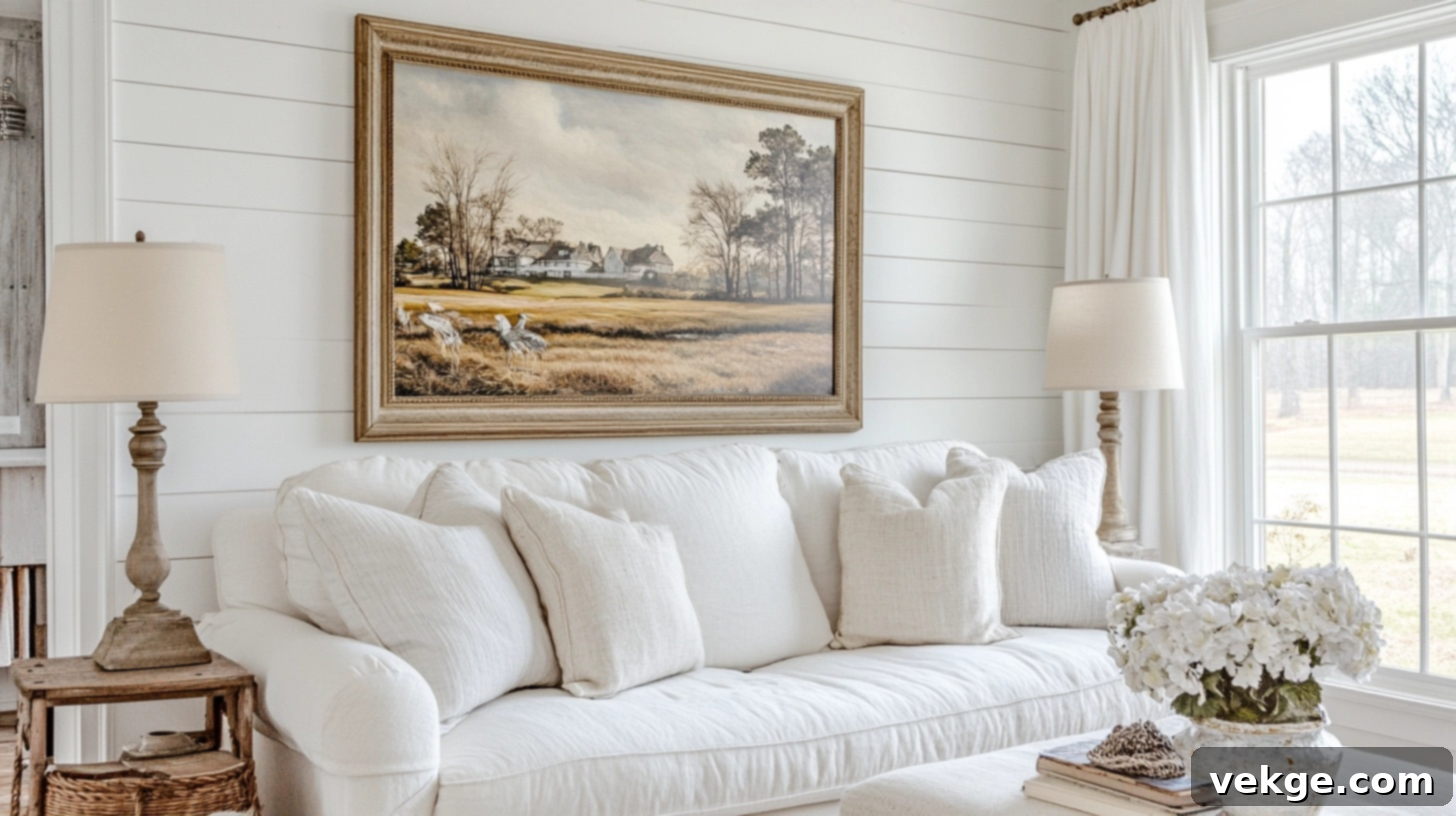
Shiplap walls are arguably the most recognizable element of the Fixer Upper style, instantly injecting visual interest and a charming sense of history into any living area. Whether applied horizontally for a classic farmhouse look or vertically for a more modern aesthetic, this wall treatment transforms an ordinary room into one brimming with character. It’s particularly effective when used as a focal point – imagine a shiplap wall behind your sofa, framing a fireplace, or serving as a backdrop for your entertainment console. It offers a subtle texture that creates depth and warmth without overwhelming the space.
DIY-Friendly Options: If the thought of traditional shiplap installation feels daunting, several accessible alternatives exist. Consider high-quality peel-and-stick shiplap panels, which offer a similar aesthetic with significantly less effort and mess, making it a perfect weekend DIY project. Another budget-friendly method involves cutting thin plywood sheets into strips and installing them with small gaps, mimicking the look of authentic shiplap. Paint it white, cream, or a soft gray to brighten the room and enhance its rustic appeal.
2. Rustic Wood Ceiling Beams: Elevating Your Living Room’s Architecture
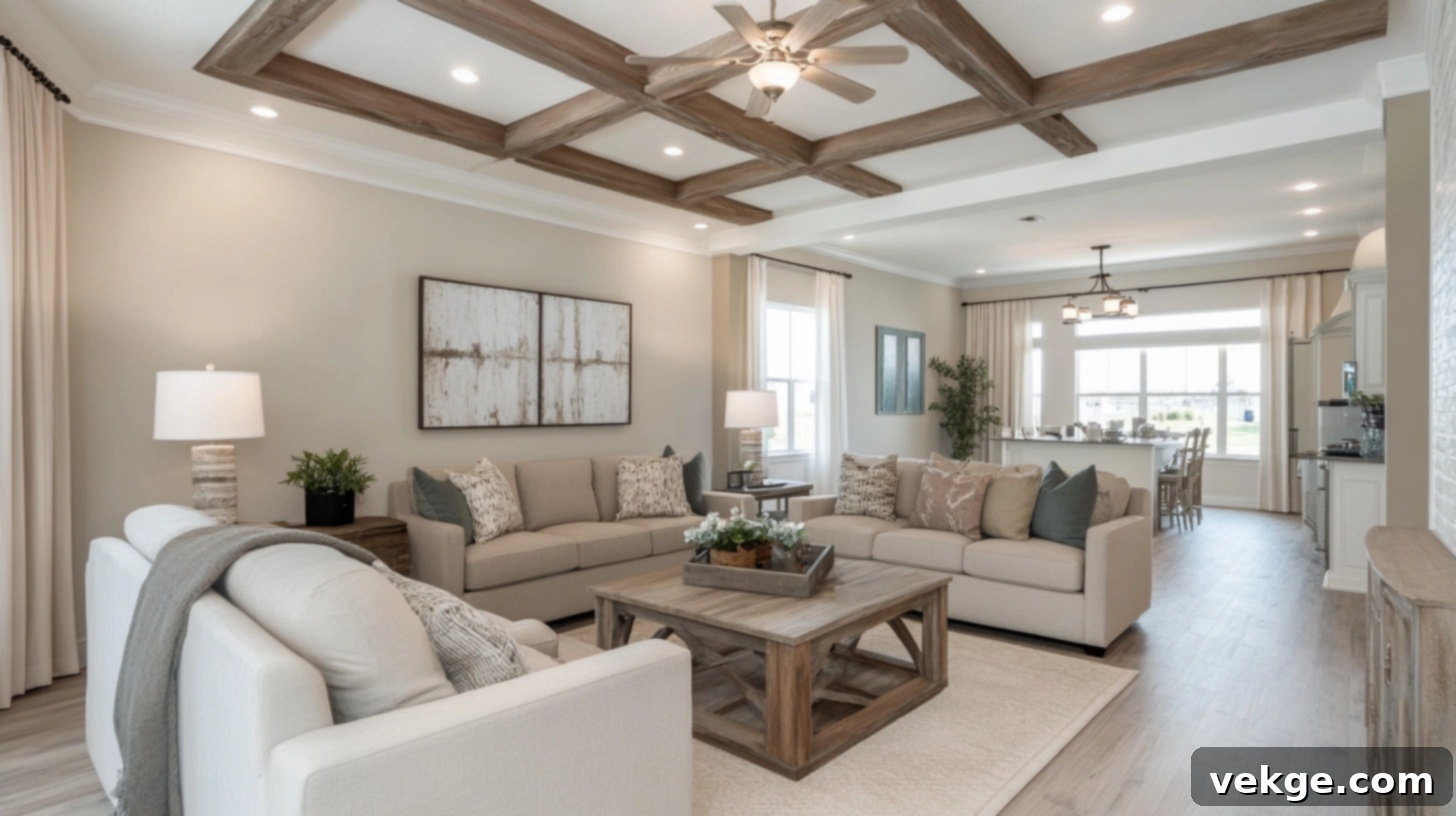
Nothing adds architectural gravitas and a touch of grand farmhouse elegance quite like rustic wood ceiling beams. These structural or decorative elements instantly draw the eye upwards, transforming flat, uninspired ceilings into dynamic focal points that exude warmth and a sense of history. In older homes, restoring original beams can highlight existing character, while in newer constructions, adding real or faux beams can imbue the space with an immediate feeling of age and master craftsmanship.
Design Considerations: When selecting beams, consider the overall scale of your room and ceiling height. For a lighter, more contemporary Fixer Upper aesthetic, opt for lighter-toned wood beams (such as natural oak or white-washed pine) against a crisp white ceiling. This creates a striking contrast without making the room feel heavy or smaller. Darker, more substantial beams can be magnificent in rooms with very high ceilings, offering a dramatic, stately presence. Faux beams made from lightweight materials are an excellent, budget-friendly alternative that provides the same visual impact without the structural challenges or cost of solid wood.
3. Embracing Open Concept Living Layouts for Flow and Light
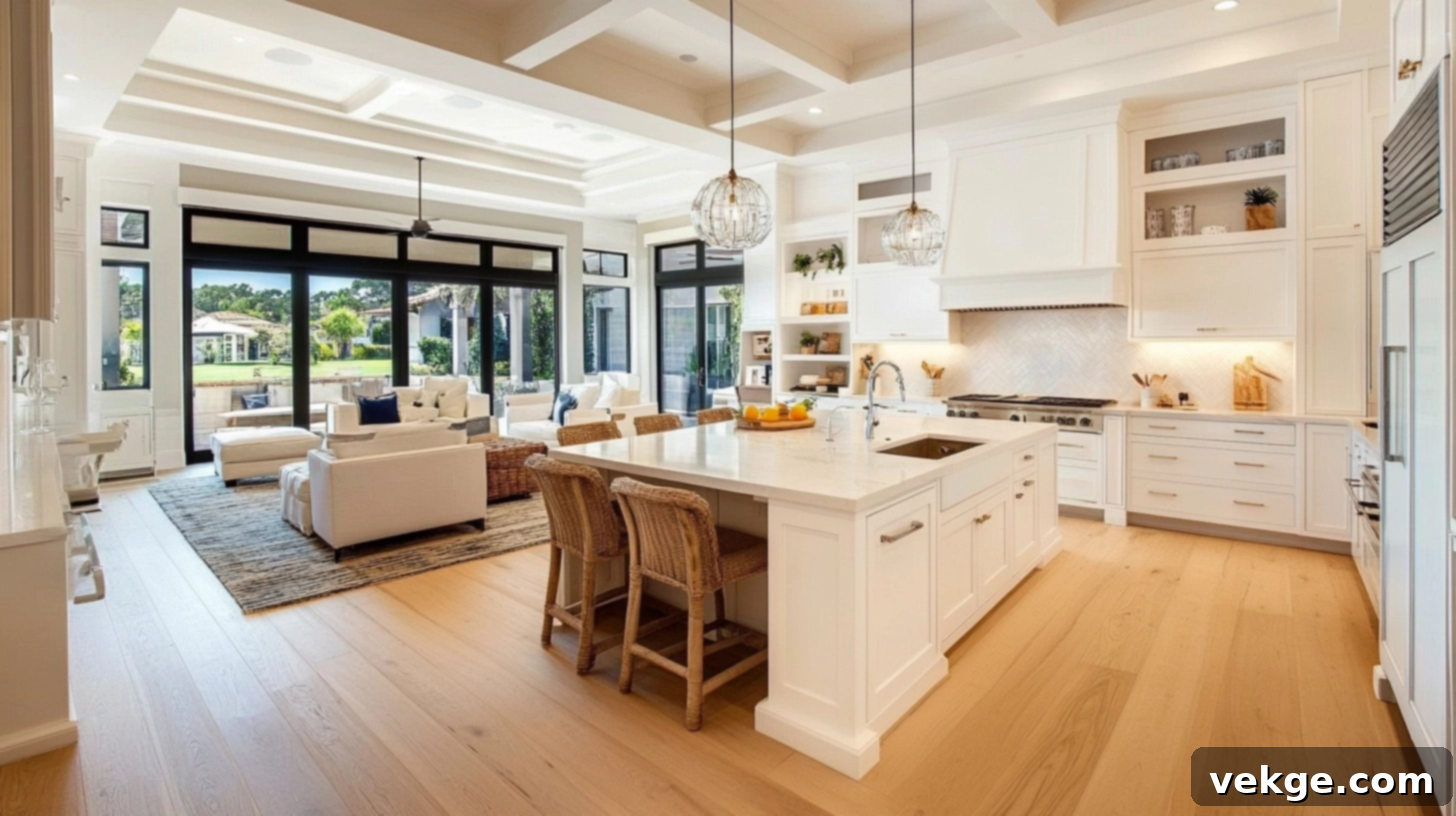
A hallmark of modern living, often integrated into Fixer Upper renovations, is the open concept layout. The removal of walls between key living areas, particularly between the living room and kitchen or dining space, radically transforms the home’s functionality and aesthetic. This design choice instantly creates a more fluid, cohesive environment, allowing natural light to penetrate deeper into the home and making both individual spaces feel significantly larger and more airy.
Benefits and Planning: Beyond the visual appeal, open layouts greatly enhance social interaction, making entertaining friends and family a breeze. Hosts can remain part of the conversation while preparing meals, fostering a more connected living experience. However, careful planning is crucial. Before considering any wall removal, it is absolutely essential to consult with a qualified building expert or structural engineer to determine if the walls are load-bearing. This step ensures safety and structural integrity throughout your renovation project, making sure your open concept dream is realized responsibly.
4. Crafting Serenity with a Neutral Color Palette
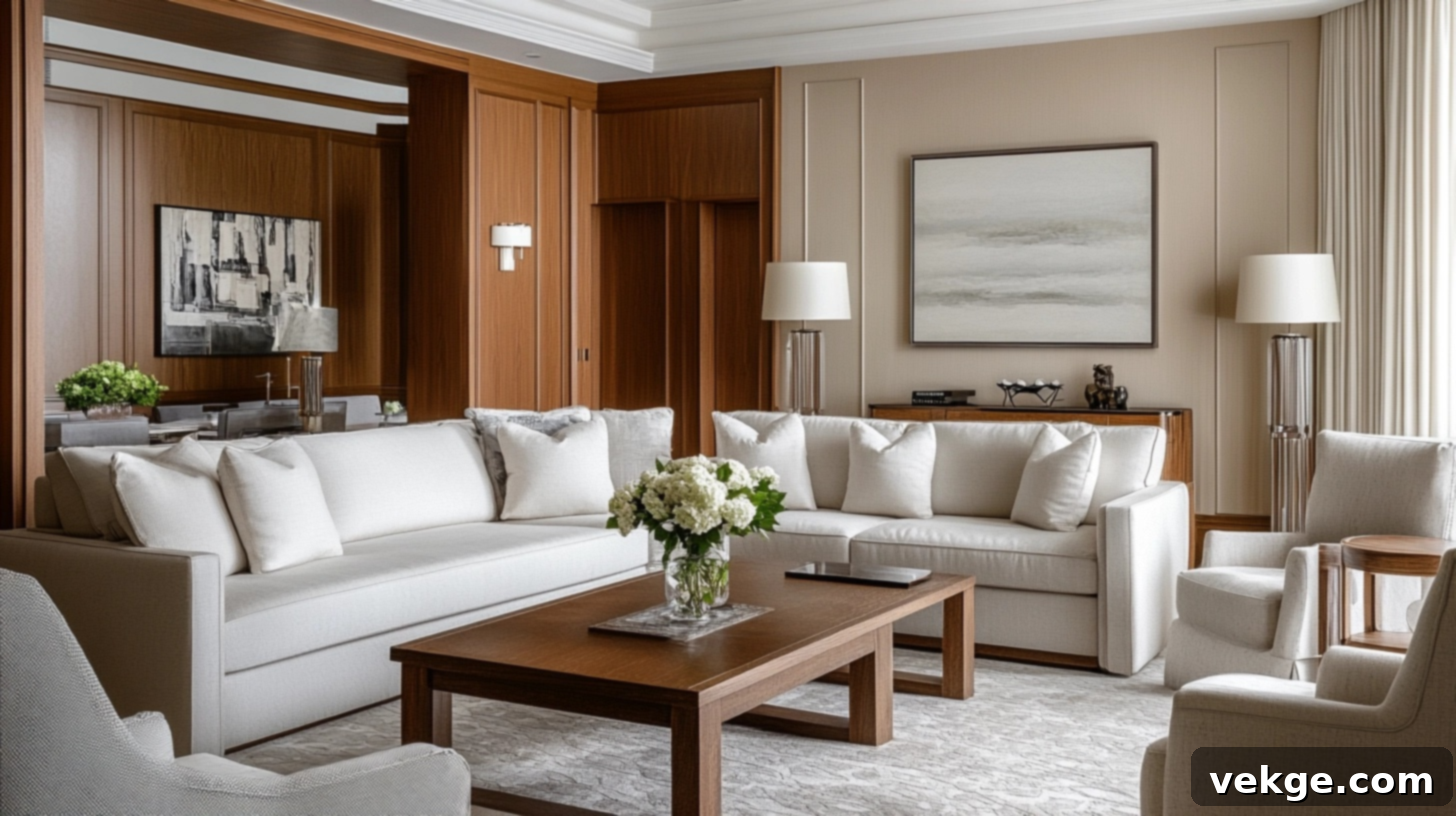
The foundation of any successful Fixer Upper living room is a serene and versatile neutral color palette. Soft, muted tones are more than just aesthetically pleasing; they create a calm, expansive base that acts as a perfect canvas for various textures, natural elements, and seasonal decorative changes. Shades like crisp whites, warm creams, inviting off-whites, and sophisticated light grays are staples, chosen for their ability to reflect light and make spaces feel brighter and more open. These hues pair exquisitely with natural wood tones, creating an effortlessly clean, yet incredibly warm and welcoming ambiance.
Adding Personality: While neutrals dominate the larger surfaces, they also provide the ideal backdrop for carefully introduced pops of color and personality. This is where accent pieces come into play. Incorporate vibrant or subtle splashes of color through easily changeable items such as decorative pillows, cozy throw blankets, framed artwork, or fresh floral arrangements. This strategy allows you to refresh the room’s mood and adapt it to different seasons or preferences without committing to a permanent color scheme, offering both flexibility and endless styling possibilities.
5. The Heart of the Home: A Farmhouse Mantel and Fireplace
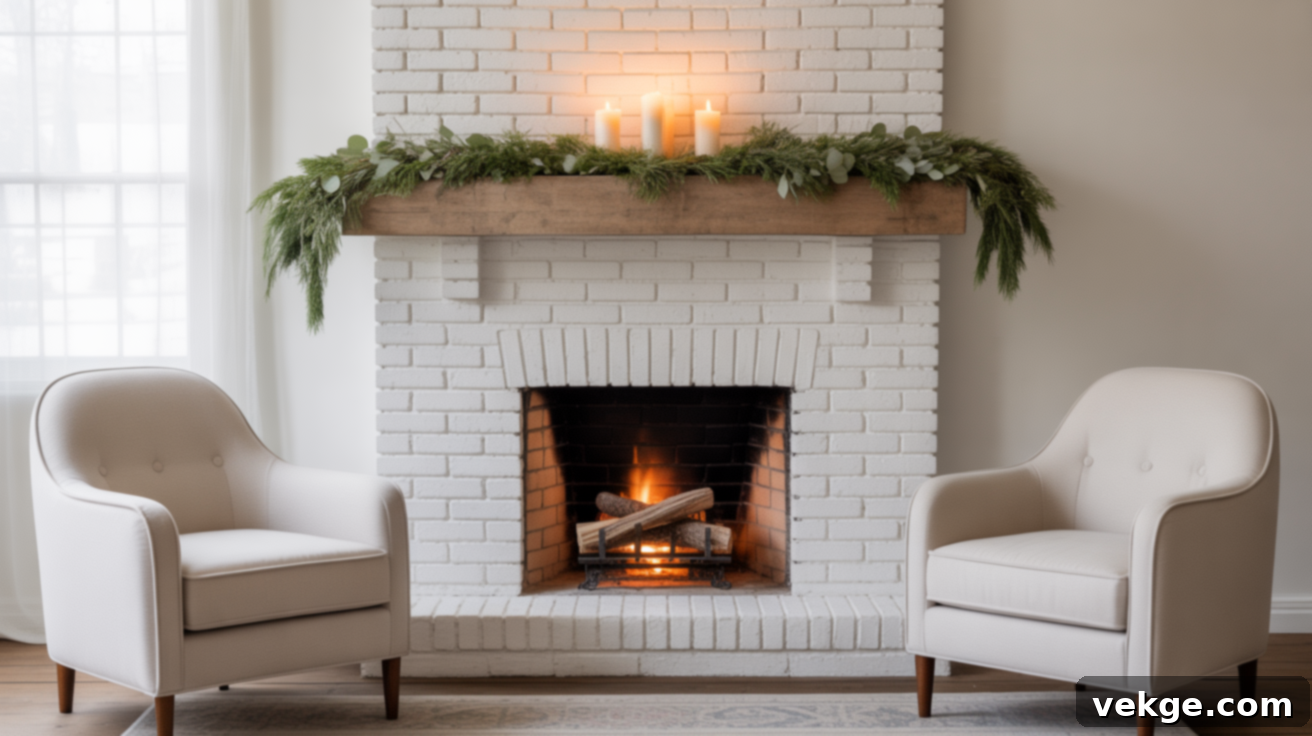
In many Fixer Upper living rooms, the fireplace serves as the undeniable focal point and emotional heart of the space. A thoughtfully designed fireplace and mantel draw the eye, radiating warmth and creating an inviting atmosphere that encourages gathering and relaxation. The materials chosen for the fireplace surround and mantel are key to achieving the desired farmhouse aesthetic.
Styling Your Fireplace: Options range from classic brick, often painted a soft white or cream to lighten its presence, to natural stone or a more minimalist concrete finish. The mantelpiece itself is an opportunity to add significant character. A substantial raw wood mantel beam, either reclaimed or newly distressed, instantly conveys a sense of rustic charm and history. Alternatively, a crisp white wooden mantel offers a cleaner, more refined farmhouse look. Decorate your mantel with a curated selection of items: vintage clocks, framed art, antique books, fresh greenery, or layered mirrors to enhance its appeal and personal touch.
Fireplace Alternatives: For homes without an existing fireplace or chimney, you don’t have to miss out on this central feature. Modern electric fireplace inserts offer the visual warmth and ambiance of a real fire, complete with realistic flames and heat output, without the need for complex installation or ventilation. These can be beautifully integrated into a custom-built surround, complete with a farmhouse mantel, providing all the aesthetic benefits without the maintenance of a traditional wood-burning fireplace.
6. The Art of Layered Rugs: Adding Warmth and Dimension
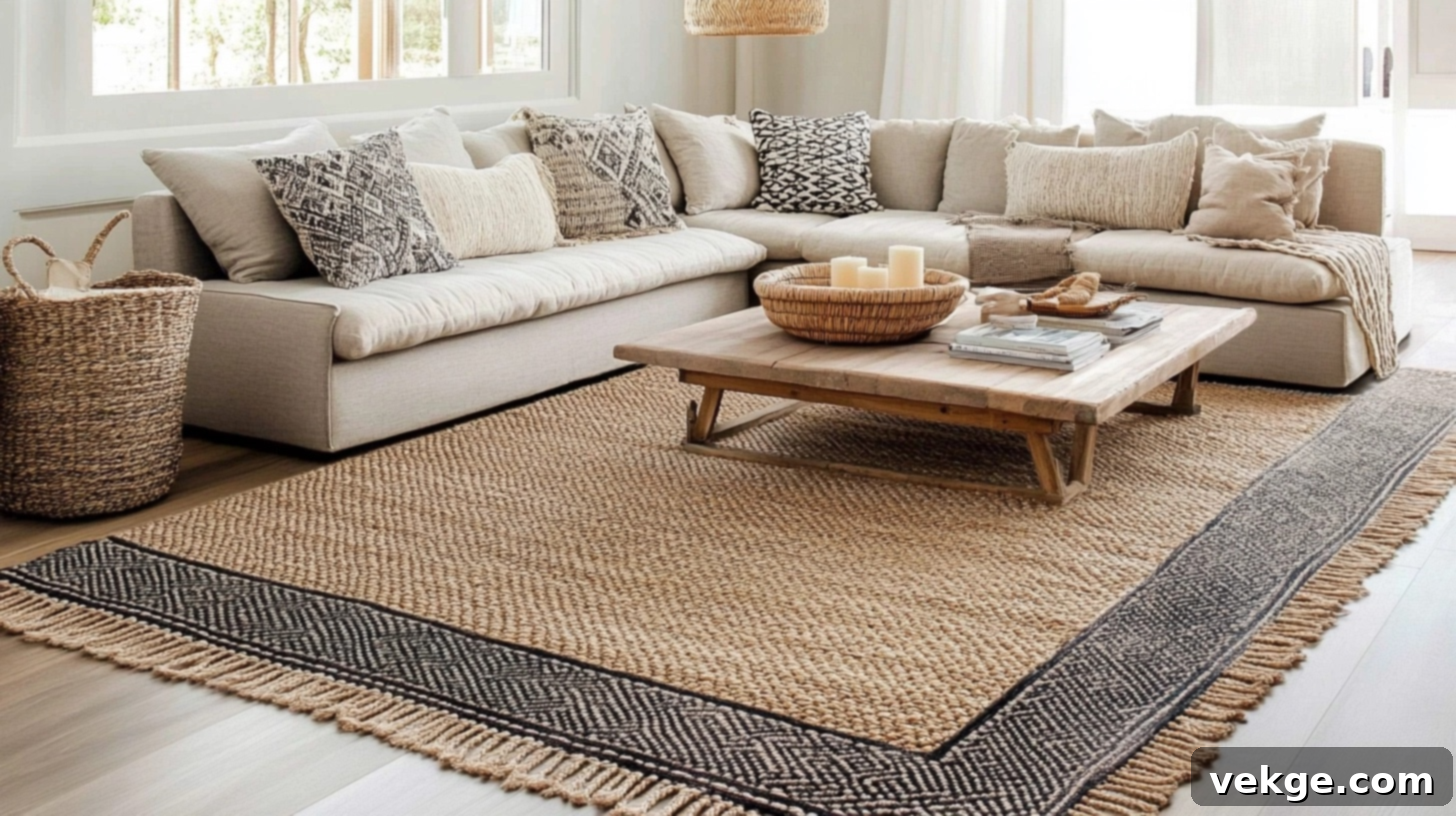
Layering rugs is a clever and visually rich technique frequently seen in Fixer Upper designs, instantly adding immense depth, texture, and an extra layer of softness underfoot. This approach works particularly well in living rooms, creating a more intimate and cozy zone within a larger space or simply enhancing the warmth of bare floors.
How to Layer: Begin with a generously sized, flat-woven natural fiber rug as your base. Materials like jute, sisal, or a large cotton dhurrie provide a grounding, organic texture. This base rug should be large enough to extend under the front legs of your main seating furniture, defining the seating area. On top of this, position a smaller, perhaps more decorative rug. This top layer is where you can introduce pattern, a pop of color, or a contrasting texture—think a vintage Persian rug, a geometric design, or a plush sheepskin. This method not only enhances the room’s aesthetic but is also a fantastic budget-smart solution, allowing you to invest in a smaller, more unique, or costly rug for the top layer while still achieving broad coverage with an affordable base.
7. Timeless Charm with Vintage-Inspired Coffee Tables
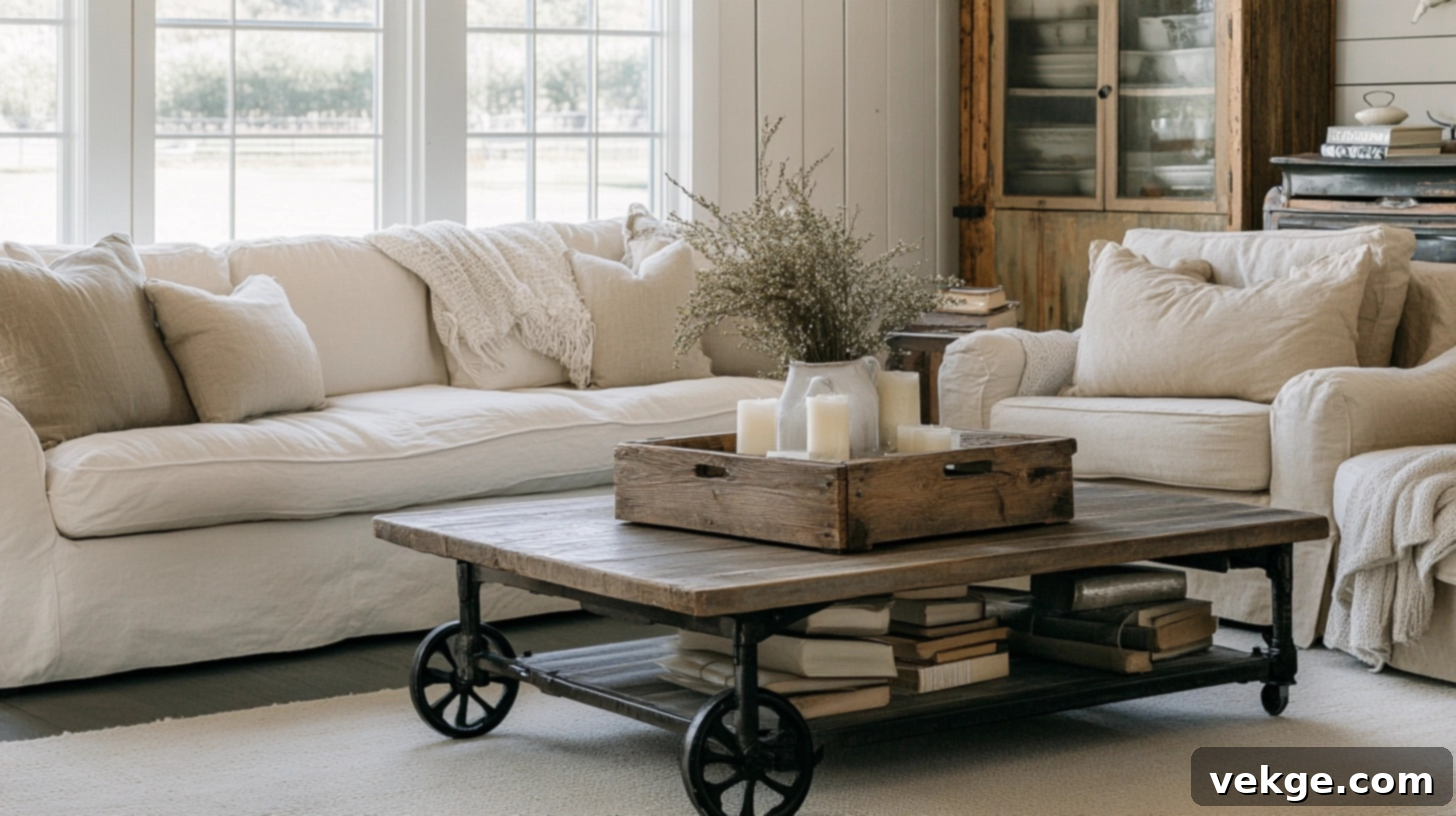
A coffee table is often the centerpiece of a living room, and in a Fixer Upper aesthetic, it’s an opportunity to infuse the space with character and a sense of enduring history. Vintage-inspired or genuinely antique coffee tables become instant conversation starters, grounding the room with their unique stories and charming imperfections. Look for pieces that exhibit worn finishes, distressed paint, robust metal accents like industrial wheels, or beautifully turned legs that harken back to bygone eras. These details elevate a simple functional item into a cherished design element.
Sourcing and DIY: Hunting for these treasures can be part of the fun! Explore local antique shops, flea markets, thrift stores, and online marketplaces for hidden gems. For those on a tighter budget or who enjoy a hands-on approach, a DIY transformation is incredibly rewarding. Take an ordinary or second-hand coffee table with good bones, and with some paint, sandpaper, and a little wax or glaze, you can create your own beautifully aged, time-tested look. Experiment with chalk paint for an easy distressed finish, or simply sand down a modern piece to reveal the natural wood grain, creating a custom piece that perfectly complements your Fixer Upper vision.
8. Striking a Balance with Industrial Lighting Fixtures
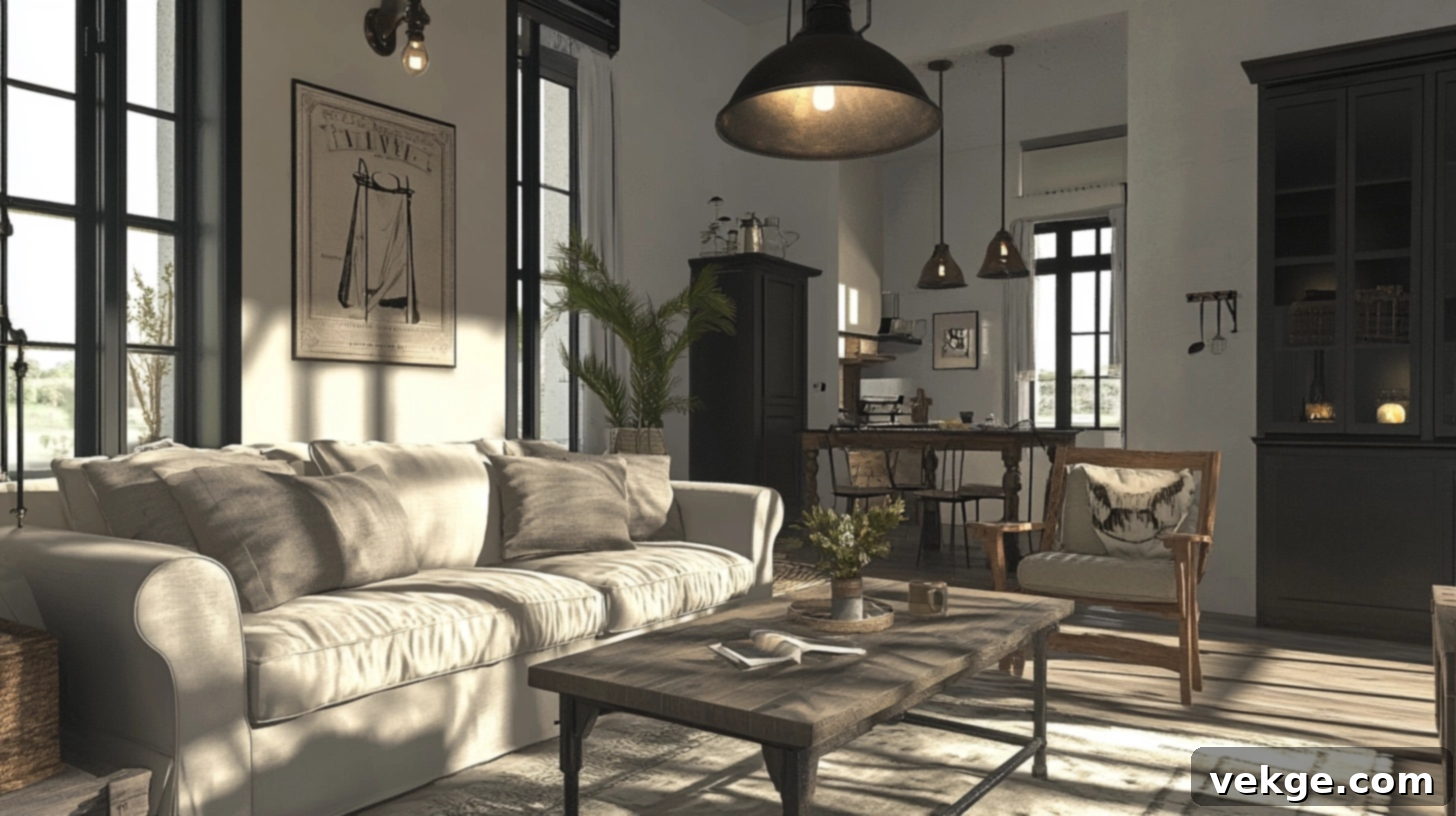
To prevent a Fixer Upper living room from becoming overly rustic or country, the introduction of industrial lighting fixtures is a brilliant design strategy. The raw, utilitarian aesthetic of metal lighting provides a crucial balance to the softer, warmer elements like plush fabrics, natural wood, and woven textures. These fixtures introduce a touch of modernity and an edge that feels both historic and contemporary.
Types and Placement:
- Pendant Lights: Oversized pendant lights with black, aged bronze, or matte nickel finishes can create dramatic, eye-catching focal points. Hang them individually or in a cluster above a coffee table, a reading nook, or to delineate a specific seating area.
- Wall Sconces: Industrial-style wall-mounted sconces are highly functional and stylish. They are perfect for providing ambient or task lighting without cluttering side tables, making them ideal for smaller living rooms or beside a reading chair. They add a sophisticated, old-world factory charm.
- Floor and Table Lamps: Look for lamps with metal bases, exposed bulbs, or cage designs. These add another layer of industrial flair and contribute to the overall lighting plan, ensuring adequate illumination for all activities.
The clean lines and robust materials of industrial lighting fixtures reinforce the “modern” aspect of the farmhouse-modern blend, ensuring the space feels curated and dynamic.
9. Maximizing Space and Style with Floor-to-Ceiling Built-ins
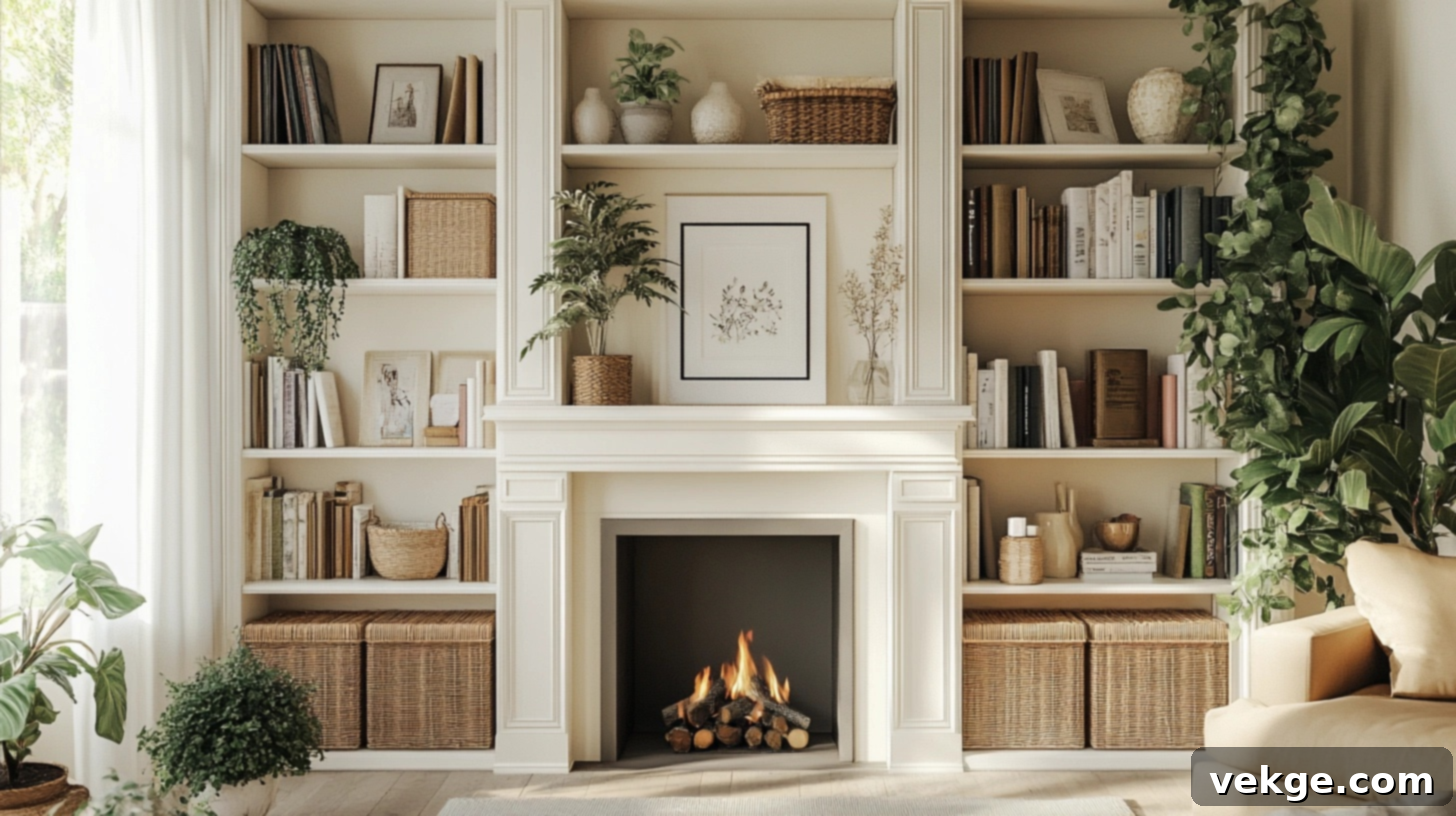
Floor-to-ceiling built-in shelving is a quintessential Fixer Upper feature, celebrated for its ability to combine practicality with sophisticated design. These custom units maximize vertical wall space, offering abundant storage and display opportunities that feel perfectly integrated into the room’s architecture rather than merely resting against a wall. They provide designated spots to showcase cherished book collections, decorative objects, family photographs, and functional storage items, all while maintaining a streamlined aesthetic.
Design and Styling Tips:
- Color and Finish: Opt for built-ins painted in the same neutral shades as your walls—white, cream, or light gray. This choice ensures the units blend seamlessly, keeping the room feeling light, open, and spacious, even when the shelves are full.
- Thoughtful Curation: The key to beautifully styled shelves is thoughtful curation, not clutter. Avoid the temptation to fill every inch. Instead, leave ample negative space, allowing individual items to breathe and stand out.
- Mix and Match: Create visual interest by mixing both functional and decorative items. Combine stacks of books with unique sculptures, potted plants, woven baskets for hidden storage, and framed artwork. Vary the height and texture of your display items to create a dynamic arrangement.
- Symmetry and Asymmetry: Experiment with both symmetrical and asymmetrical arrangements for a balanced yet organic feel.
Built-ins add significant value and character, making your living room feel custom-designed and incredibly functional.
10. Cozy Comfort: Soft Linen or Cotton Slipcovered Sofas
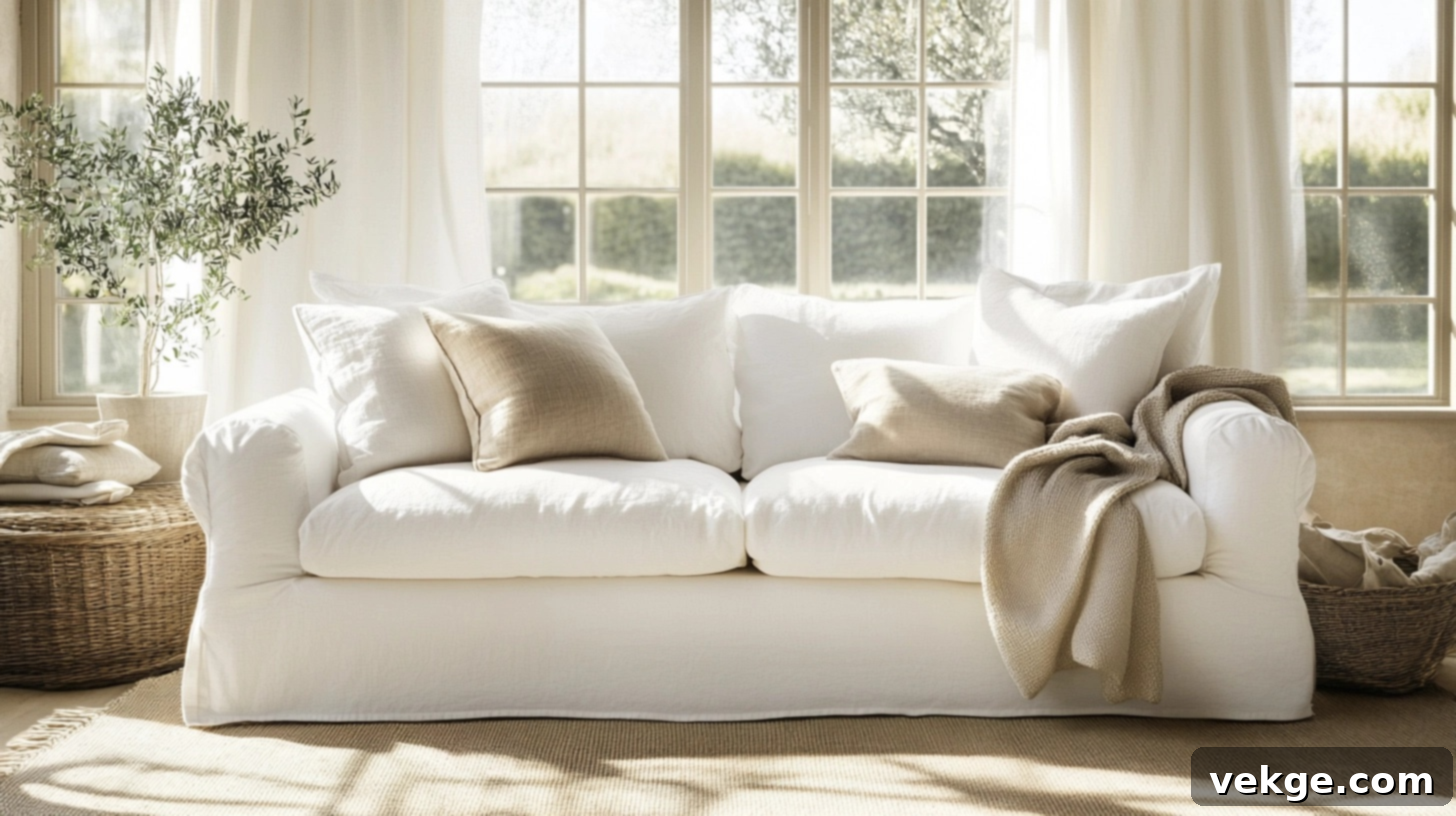
The ultimate embodiment of relaxed elegance in a Fixer Upper living room is undoubtedly the soft, inviting slipcovered sofa. More than just a comfortable place to sit, these couches bring a wonderfully casual and lived-in feeling to any space, perfectly balancing style with the demands of real-life living. Their inherent practicality makes them an indispensable choice, especially for bustling homes with children, pets, or frequent guests.
Practicality Meets Style: The genius of slipcovers lies in their removability and washability. Accidental spills, pet paw prints, or everyday wear and tear are no longer major concerns; simply remove the cover and toss it into the washing machine for a fresh, clean look. This feature ensures your living room always looks pristine and welcoming without the stress of permanent stains.
Fabric and Color Choices: For that authentic, timeless Fixer Upper style, opt for natural fabrics like breathable linen or durable cotton. These materials offer a beautiful texture and drape, enhancing the sofa’s relaxed appeal. Stick to classic neutral colors such as creamy whites, soft off-whites, versatile light grays, or gentle beiges. These hues not only provide a serene backdrop for your decor but also contribute to a sense of enduring style that will remain fashionable for years to come.
11. Making a Statement with Oversized Wall Clocks or Signs

In the Fixer Upper aesthetic, large-scale wall decor plays a significant role in creating visual impact and utilizing often-overlooked vertical space. Oversized wall clocks or rustic wooden signs serve as powerful statement pieces, drawing the eye upwards and adding a focal point to any living room. These singular, commanding items can effectively fill a large, empty wall without the need for a multitude of smaller pieces that might otherwise lead to a cluttered or busy appearance.
Choosing Your Statement Piece:
- Oversized Clocks: A large, industrial-style clock with exposed gears or classic Roman numerals offers both functionality and a strong design presence. Opt for finishes like aged metal, distressed wood, or a simple painted white or black face to align with the farmhouse-modern vibe.
- Rustic Wooden Signs: Hand-painted or stenciled wooden signs featuring meaningful words, family names, or classic farmhouse motifs (like “Gather” or “Home Sweet Home”) bring warmth and a personal touch. Consider reclaimed wood for an authentic, weathered look.
The key is to select pieces that are simple in design and not overly ornate. This minimalist approach ensures that your statement piece enhances the room’s character without making it feel overly thematic or distracting. Its scale alone provides enough visual interest, allowing the rest of your decor to complement rather than compete.
12. Curating Memories with Gallery Walls and a Personal Touch
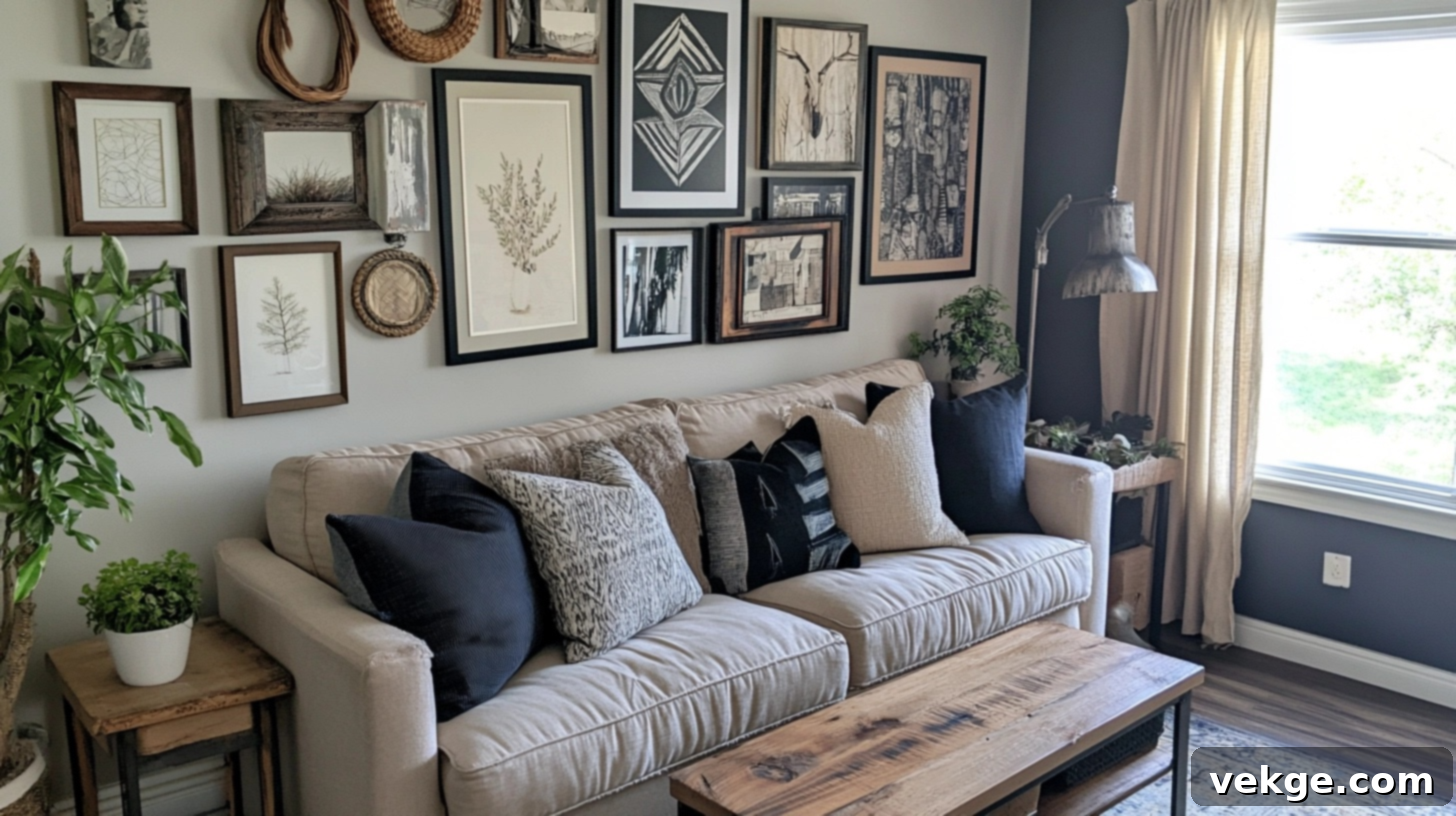
A beautifully curated gallery wall is a wonderful way to inject personality, tell your family’s story, and create a dynamic focal point in a Fixer Upper living room. It’s a collection of frames that not only adds significant visual interest but also allows you to proudly display cherished family photographs, meaningful artwork, and even small mementos that hold special significance. The key to a successful gallery wall lies in its thoughtful composition and balance.
Designing Your Gallery Wall:
- Mix and Match Frames: Don’t be afraid to combine different frame styles, sizes, and even textures. The secret to a cohesive look amidst variety is to maintain a unifying element. This could be a consistent color theme (e.g., all black frames, all white frames, or a mix of natural wood tones), or a similar finish (e.g., all distressed, all metallic).
- Content Variety: While photos are central, diversify the content. Interspersed with your family pictures, include abstract art, simple line drawings, vintage prints, typography art with inspiring quotes, or even small mirrors.
- Create Visual Breathing Room: To prevent the gallery wall from feeling cluttered, strategically incorporate a few empty frames or frames containing simple word art or a solid-colored mat board. This “negative space” allows the eye to rest and highlights the surrounding images, giving the entire arrangement a more professional and artistic feel. Lay out your arrangement on the floor first to experiment with different layouts before committing to hanging.
This personal touch elevates your living room from a mere decorated space to a heartfelt reflection of your life and style.
13. Striking Contrast with Black Framed Windows
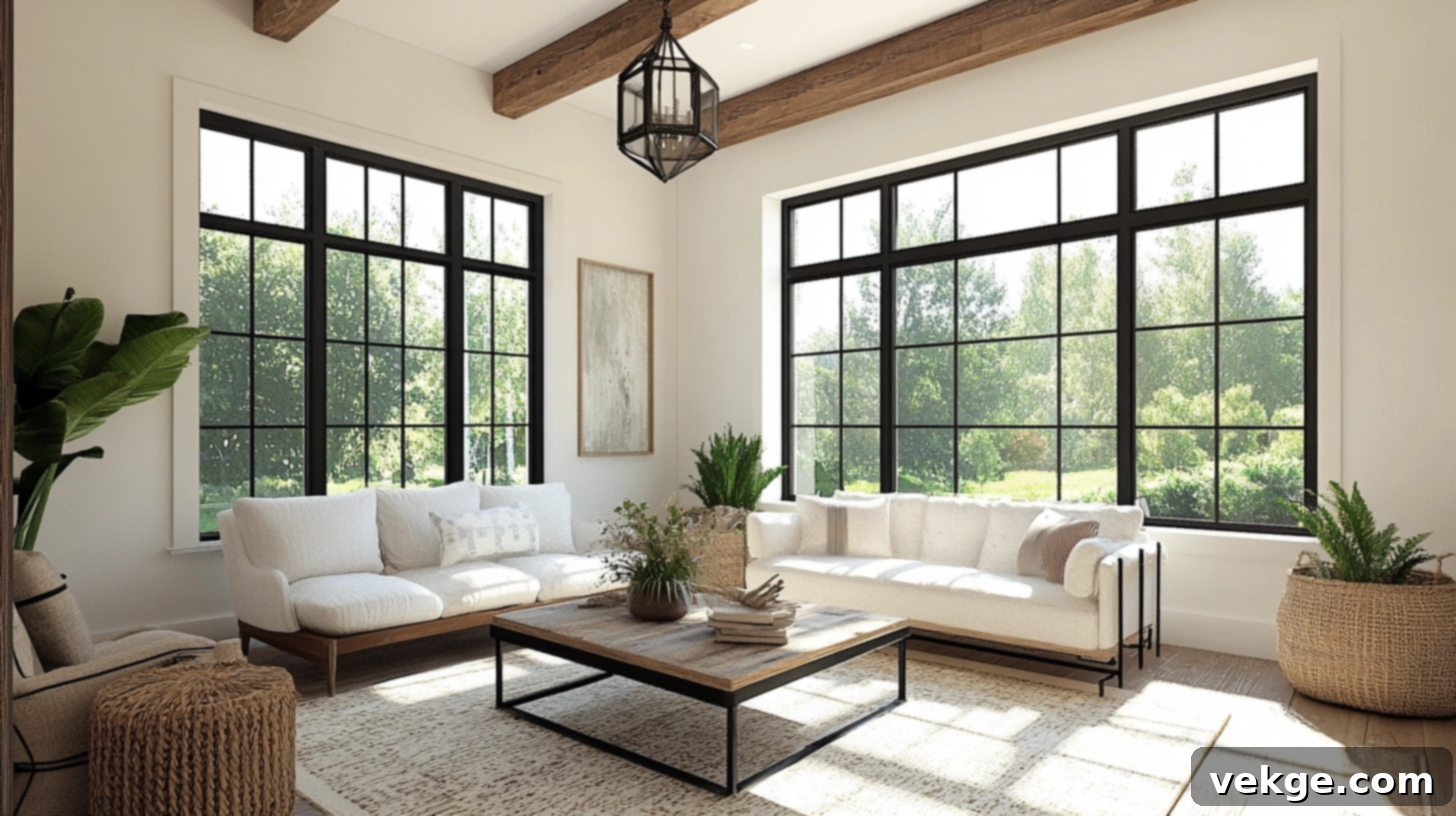
One of the most impactful modern elements that beautifully complements the rustic charm of a Fixer Upper living room is the striking presence of black-framed windows. These dark frames create crisp, architectural lines that offer a bold contrast against light-colored walls and soft neutral palettes. This deliberate juxtaposition instantly introduces a touch of contemporary sophistication and visual drama, preventing the space from feeling too traditional or overly ‘country’.
Achieving the Look: The dark frames define the window openings, drawing the eye to the views outside and adding an unexpected layer of depth to the room. They act almost like a piece of art themselves, providing structure and a modern edge. While brand-new black windows can be a significant investment, a highly effective and budget-friendly alternative is to paint your existing window frames black. With proper preparation and quality paint, this DIY project can yield a remarkably similar and stylish effect at a fraction of the cost, making this modern farmhouse detail accessible to more homeowners.
14. Bringing Life Indoors with Natural Elements and Greenery
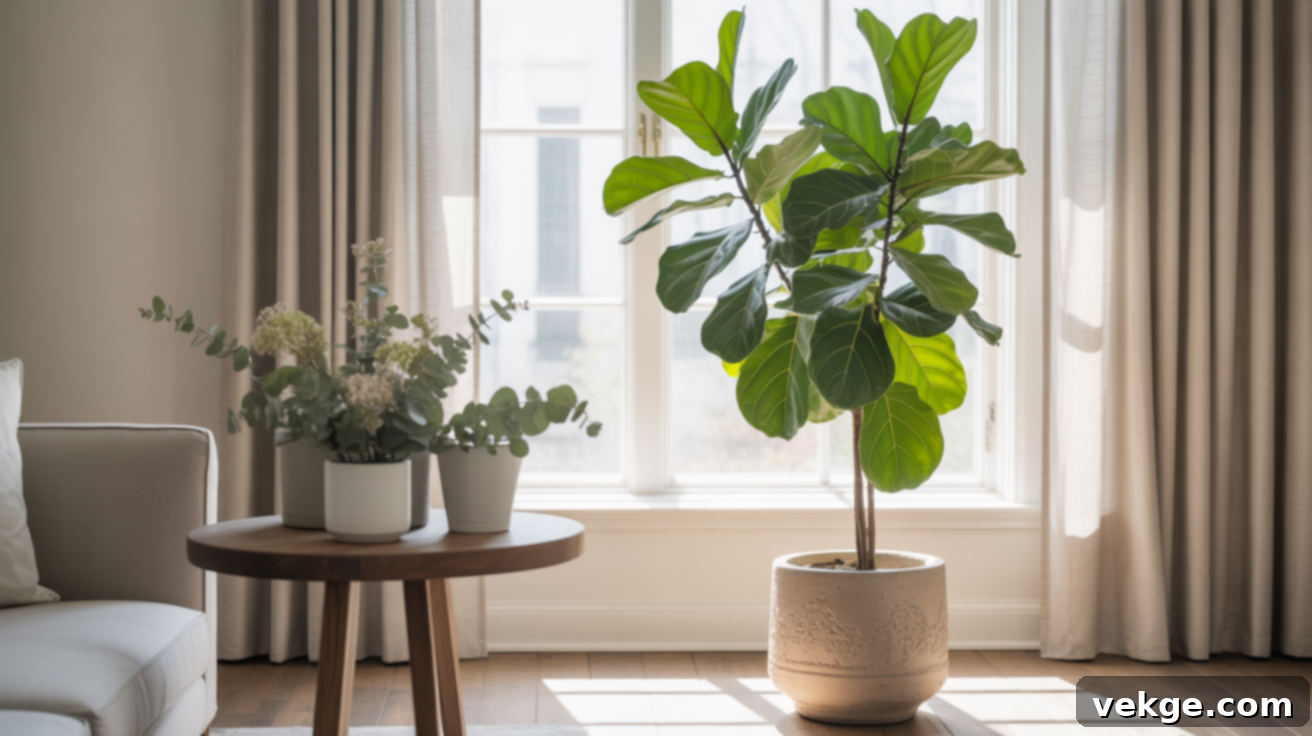
No Fixer Upper living room is complete without the refreshing touch of natural elements and vibrant greenery. Plants are more than just decorative accents; they infuse living spaces with life, introduce organic color, and contribute to improved air quality and a sense of well-being. Incorporating nature indoors creates a tranquil atmosphere, connecting the interior to the outside world.
Integrating Greenery:
- Large Statement Plants: For impactful focal points, place tall, architectural plants like olive trees, fiddle leaf figs, or bird of paradise plants in empty room corners or beside a large window. Use attractive planters made from terracotta, woven baskets, or simple ceramic to enhance their aesthetic.
- Smaller Plants for Shelves and Tables: Smaller potted plants such as snake plants, ZZ plants, or trailing ivy are perfect for filling empty shelf space, adorning coffee tables, or adding a touch of life to side tables.
- Low-Maintenance Options: For those without a green thumb or who travel frequently, there are excellent low-effort alternatives. Dried eucalyptus branches, cotton stems, or carefully selected, high-quality faux plants offer the visual appeal of greenery without the need for constant watering or care. These options provide enduring beauty and freshness to your Fixer Upper living room year-round.
Beyond plants, consider incorporating other natural textures like woven baskets, stone accessories, or rough-hewn wood bowls to further enhance this organic connection.
15. Functional Farmhouse Flair: Sliding Barn Doors
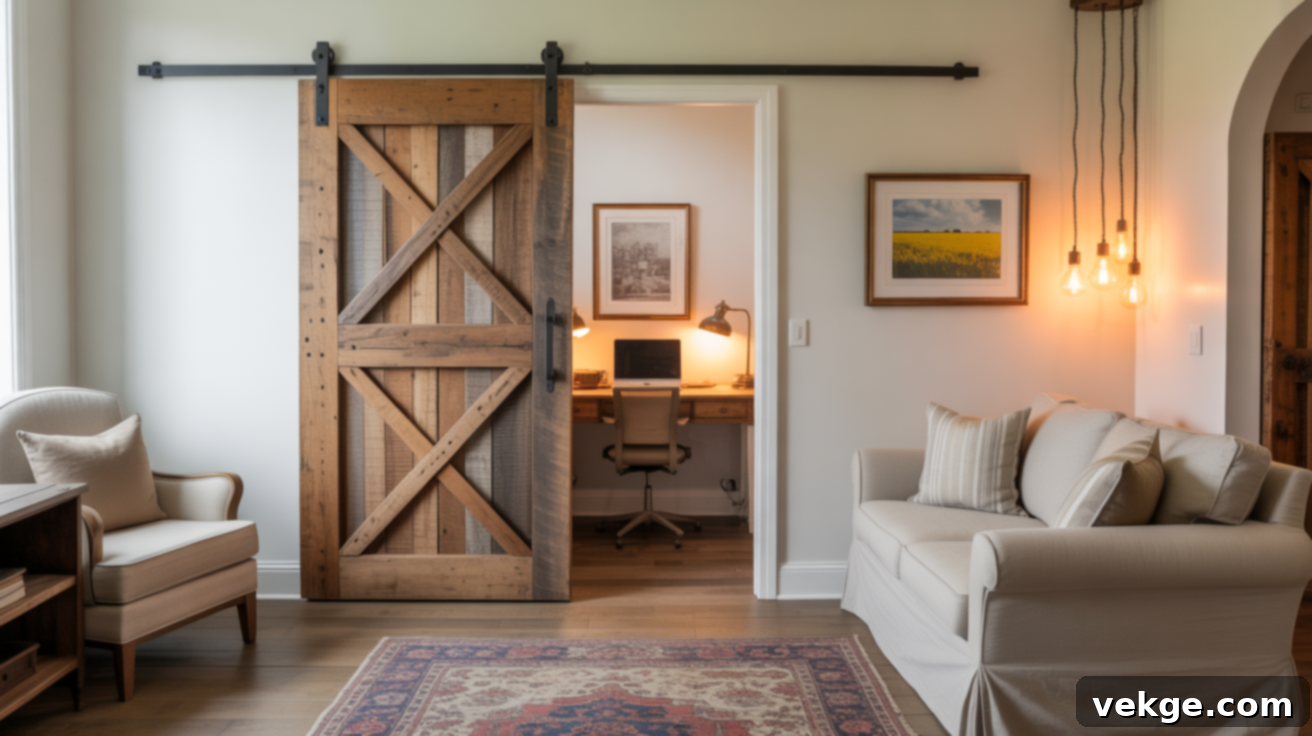
Sliding barn doors are a fantastic marriage of rustic charm and practical functionality, making them a popular feature in Fixer Upper homes. Beyond their aesthetic appeal, these space-saving doors are incredibly useful in layouts where traditional swing doors might impede flow or take up valuable floor space. Their distinctive sliding mechanism adds an instant touch of country elegance and architectural interest that becomes a focal point itself.
Strategic Placement and Styling: Barn doors excel at providing flexible separation without permanent closure. They work beautifully for:
- Concealing Entertainment: Sliding shut to hide a TV area when not in use, creating a more serene environment.
- Home Office Integration: Providing a visual and acoustic barrier for a home office nook within a larger living space.
- Pantry or Laundry Closets: Offering stylish access to utilitarian spaces connected to the living room.
- Room Dividers: Creating a soft division between an open living room and dining room or entry.
When selecting a barn door, consider its finish. A natural wood finish that harmonizes with other wood tones in your room (flooring, beams, furniture) will create a cohesive and thoughtful look. Alternatively, a painted barn door (white, black, or a soft gray) can offer a cleaner, more modern farmhouse appeal. The hardware itself (track and handles) also contributes to the industrial-meets-farmhouse vibe, so choose pieces that complement your overall design.
16. Creative Display with Vintage Ladder Shelving
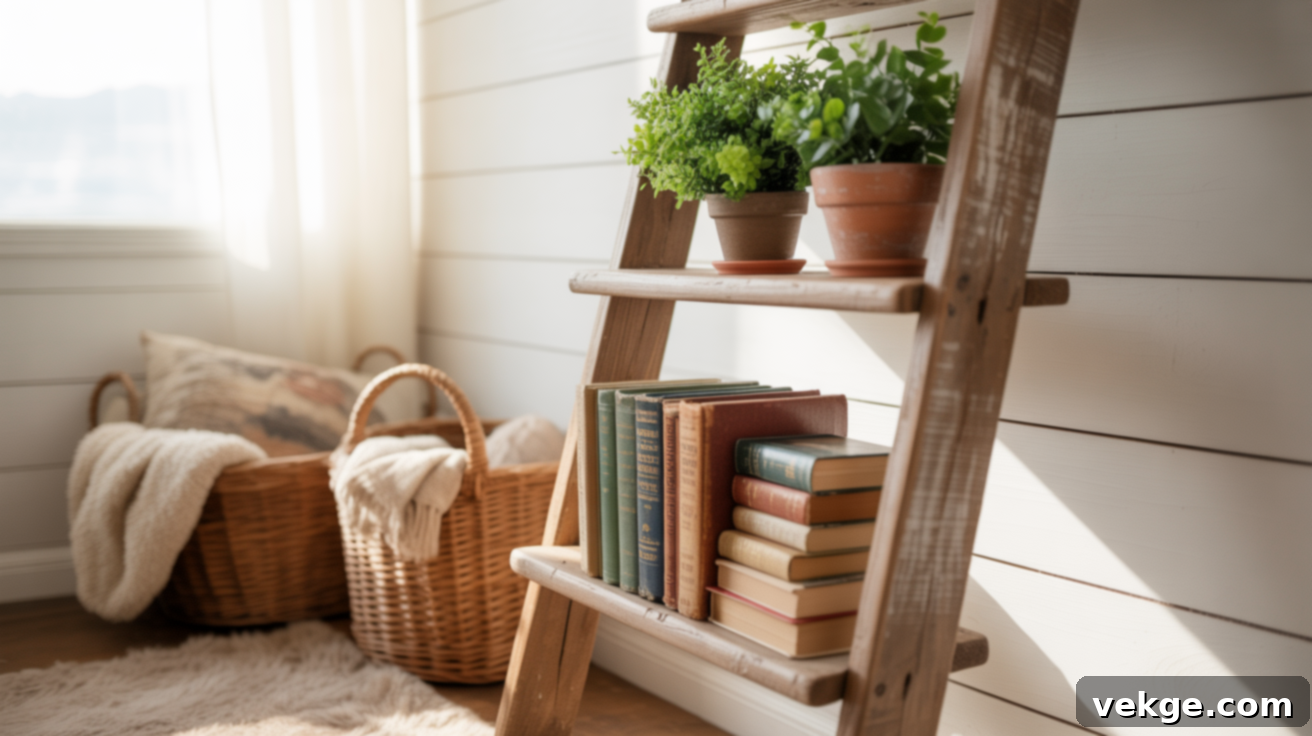
Repurposing an old wooden ladder into a charming display or shelving unit is a wonderfully creative way to add character, vertical interest, and functional storage to your Fixer Upper living room. These unique pieces instantly evoke a sense of history and rustic charm, serving as a captivating alternative to traditional bookcases or wall shelves. Their slender profile ensures they don’t consume much floor space, making them ideal for smaller rooms or tight corners.
Versatile Styling Options:
- Leaning Ladder Display: The simplest approach is to carefully lean a sturdy, weathered wooden ladder against an empty wall. Secure it at the top for safety. Each rung then becomes a narrow, open shelf, perfect for showcasing small potted plants (succulents, herbs), a stack of vintage books, a collection of framed photos, or cherished decorative objects like ceramic vases or antique finds. The open design prevents a heavy, cluttered feel.
- Wall-Mounted Shelving: For a more integrated and permanent solution, consider cutting an old wooden ladder in half vertically. Mount these two halves horizontally to the wall using robust, decorative brackets. This ingenious method creates multiple levels of unique wall shelving with a custom, built-in look, all while preserving the rustic integrity of the original ladder.
Regardless of how you use it, a vintage ladder adds a distinctive, handcrafted touch that speaks to the Fixer Upper ethos of repurposing and celebrating age-old materials.
17. Revitalizing Pieces with Two-Tone Painted Furniture
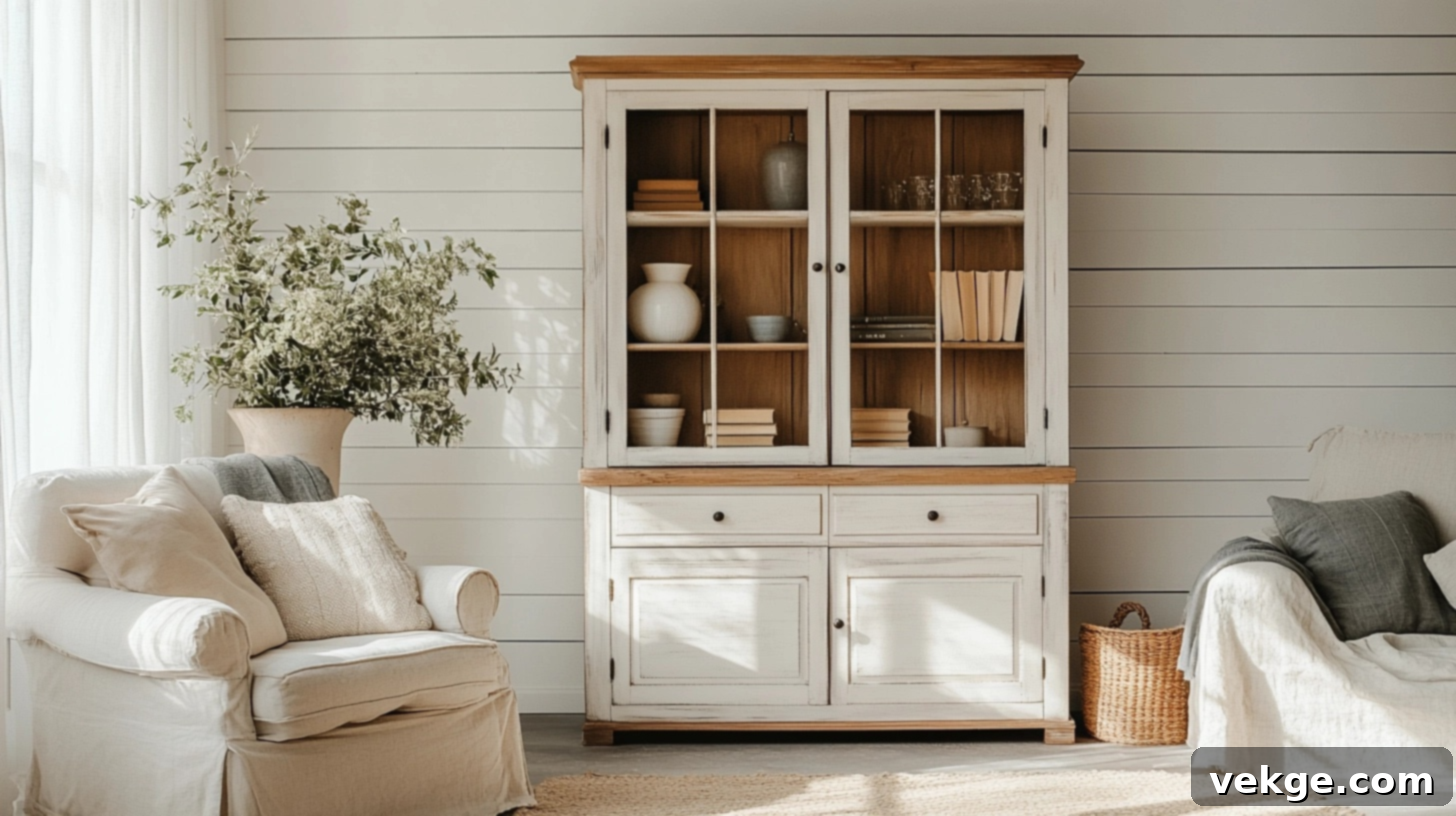
One of the most satisfying and budget-friendly ways to infuse your living room with signature Fixer Upper charm is by giving existing or second-hand furniture a fresh lease on life with a two-tone paint treatment. This technique allows you to create custom-looking pieces that appear high-end and thoughtfully designed, without the hefty designer price tag. It’s a fantastic way to personalize your space and celebrate the beauty of repurposed items.
Applying the Two-Tone Technique:
- Ideal Furniture Candidates: This technique works exceptionally well on larger furniture pieces with distinct sections, such as hutches, buffets, console tables, dressers, or even bookshelves. These pieces naturally lend themselves to highlighting different components.
- Color Combinations: The most common and effective approach in Fixer Upper style is to paint the main body of the furniture piece in a soft, neutral color—think classic white, creamy off-white, light gray, or a subtle sage green. For the contrasting element, choose to highlight drawers, cabinet doors, or the tabletop. This could be done by painting them in a darker complementary neutral (like charcoal gray), a soft contrasting color (like a muted blue), or by sanding them down to reveal and seal the beautiful natural wood grain underneath.
- Finishing Touches: To enhance the farmhouse aesthetic, consider lightly distressing the edges of the painted sections to suggest age and wear. Update hardware with vintage-style pulls or knobs in bronze, matte black, or brushed nickel. This simple weekend project can transform an ordinary piece of furniture into a standout focal point that radiates bespoke character and charm, perfectly aligning with the farmhouse modern aesthetic.
Achieving the Fixer Upper Look on a Budget: Smart Strategies
Dreaming of a Fixer Upper living room but concerned about the cost? The good news is that this iconic style is incredibly accessible, even on a modest budget. The secret lies in strategic spending, resourceful sourcing, and focusing on high-impact, cost-effective changes. It’s about being clever and creative with your choices to achieve a luxurious look without breaking the bank.
Shop Secondhand and Unleash Your Inner Treasure Hunter
One of the most authentic and budget-friendly ways to infuse your living room with Fixer Upper charm is by embracing the thrill of secondhand shopping. The most captivating pieces often come with a rich history, unique imperfections, and, most importantly, a significantly smaller price tag than new items. These aren’t just pieces of furniture; they’re conversation starters brimming with character.
Where to Hunt for Gems:
- Local Thrift Stores & Consignment Shops: Regularly visit these spots for ever-changing inventory.
- Yard Sales & Estate Sales: Often yield unexpected treasures at unbeatable prices.
- Flea Markets & Antique Malls: Great for unique, curated finds.
- Online Marketplaces: Platforms like Facebook Marketplace, Craigslist, and local buy/sell groups are goldmines for affordable furniture.
When shopping, prioritize solid wood furniture with “good bones.” Don’t be deterred by outdated finishes, minor scratches, or worn paint. These are often superficial flaws that can be easily cleaned, sanded, painted, or stained to match your desired aesthetic. Coffee tables, side tables, dressers (which can be repurposed as console tables), and display cabinets are frequently found for a fraction of their new retail cost, offering unparalleled value and personality to your Fixer Upper living room.
Achieve Shiplap Style with DIY Kits and Smart Solutions
While authentic shiplap can be a significant investment in terms of material and labor, achieving this iconic wall treatment doesn’t have to strain your budget. The beauty of the Fixer Upper style is its accessibility, and there are several clever, cost-effective ways to get the shiplap look that feels genuine and charming.
Budget-Friendly Shiplap Options:
- Peel-and-Stick Shiplap Panels: Many home improvement stores now carry high-quality, pre-finished peel-and-stick shiplap panels. These revolutionary products offer the classic look and texture of real shiplap, but can be installed in a matter of hours, rather than days, requiring minimal tools and expertise. They are perfect for an accent wall or smaller areas.
- Plywood Strips (DIY Shiplap): For a more custom and even more budget-conscious approach, consider creating your own “faux shiplap” from thin plywood sheets. Purchase a sheet of plywood (often ¼ inch thick), have it cut into consistent strips (e.g., 6 or 8 inches wide) at your local hardware store, or cut them yourself. Install these strips onto your wall, using small spacers (like coins or painter’s stir sticks) between each board to create the characteristic gap. Finish with a fresh coat of paint in your preferred neutral shade. With basic tools and a dedicated weekend, you can craft a stunning focal wall that looks like a high-end installation at a fraction of the cost.
These DIY methods allow you to add architectural interest and character, embodying the Fixer Upper spirit of craftsmanship and resourcefulness.
Strategically Mix High-End with Affordable Finds
One of the most sophisticated strategies in interior design, particularly effective in achieving the Fixer Upper aesthetic on a budget, is the artful combination of investment pieces with more affordable finds. Savvy homeowners understand that not everything in a room needs to be expensive to look luxurious and cohesive.
Where to Invest and Where to Save:
- Invest in Core Pieces: Prioritize spending more on foundational, frequently used items that need to withstand daily wear and tear and provide lasting comfort. A high-quality, durable sofa or sectional, a sturdy coffee table, or a timeless accent chair are excellent candidates for investment. These pieces will form the backbone of your living room for years to come.
- Save on Accessories and Decor: For everything else, embrace budget-friendly options! Pair your quality sofa with stylish yet inexpensive throw pillows, cozy blankets, area rugs found on sale or secondhand, and decorative accessories from discount stores, craft shops, or even handmade.
This “high-low” approach creates a wonderfully curated, layered look that feels thoughtfully designed and rich in character, without appearing overly uniform or “cookie-cutter.” A single standout antique armoire, a custom-built bookshelf, or a unique piece of art can elevate the entire room, making the more affordable elements shine alongside it. It’s about creating a balance that feels both sophisticated and approachable.
Prioritize Paint and Texture for Immediate Impact
If you’re looking for the most transformative and budget-friendly starting point for your Fixer Upper living room, look no further than paint and texture. These two elements offer the biggest bang for your buck, creating an immediate and dramatic impact on the feel and aesthetic of your space.
The Power of Paint: A fresh coat of paint in a carefully chosen shade can instantly revitalize any room. For the Fixer Upper style, opt for light, warm neutral colors – think creamy whites, soft beiges, or gentle grays. These hues not only make spaces feel larger, brighter, and more inviting but also provide the perfect serene backdrop for your rustic and modern elements to stand out. It’s an inexpensive change that reaps enormous visual rewards.
Layering Texture: Once your walls are set, focus on introducing texture. This is how you build visual interest and warmth without needing to purchase expensive furniture. Incorporate texture through:
- Wall Treatments: Beyond paint, consider a shiplap accent wall (DIY options mentioned above!), or even subtle textured wallpaper that mimics linen or grasscloth.
- Textiles: Think chunky knit throws draped over sofas, woven baskets for storage (jute, rattan), linen curtains, and layered rugs.
- Natural Elements: Bring in wood (distressed picture frames, a small stool), stone (decorative pebbles in a bowl, a stone coaster set), or ceramics (handmade pottery).
These tactile details create depth, comfort, and a rich sensory experience. By focusing on paint and texture first, you establish a strong foundation, allowing your budget to remain intact for any larger, more permanent furniture purchases down the line, ensuring a smart and stylish approach to your Fixer Upper renovation.
Mastering the Look: Bonus Design Tips from Joanna Gaines’ Living Rooms
Beyond the core elements, a closer examination of Joanna Gaines’ most beloved living room designs reveals subtle yet powerful principles that elevate her spaces. These aren’t just decorating rules; they are design philosophies that contribute to the authentic, welcoming, and effortlessly stylish feel of a Fixer Upper home. By understanding and applying these key patterns, you can imbue your own living room with that coveted blend of polished design and comfortable livability.
Prioritize Texture Over Busy Patterns for Depth and Calm
A distinctive characteristic of Joanna Gaines’ design approach is her preference for texture over an abundance of busy patterns. While patterns certainly have their place, Gaines masterfully creates visual richness and interest through a sophisticated layering of varied textures, contributing to the serene and inviting atmosphere of her living rooms. This strategy ensures the space feels dynamic and engaging without ever appearing chaotic or overwhelming.
How to Layer Textures: Instead of relying on loud prints or bold motifs, focus on incorporating a range of tactile surfaces. Think of the interplay between the rough, natural grain of reclaimed wood, the crisp, smooth feel of linen or cotton upholstery, the intricate weaves of baskets, and the soft, plushness of a chunky knit throw blanket. Introduce metals (aged bronze, matte black), glass, and stone elements to add further material diversity. This layering builds depth and sophistication, keeping the room feeling calm and cohesive while maintaining immense visual appeal. Try adding a sheepskin rug, a raw ceramic vase, or a textured wallpaper panel to easily integrate this principle into your home.
Embrace Negative Space for an Open, Serene Atmosphere
A crucial, yet often overlooked, element in Joanna Gaines’ signature designs is her masterful use of negative space. This isn’t about empty, uninteresting areas; rather, it’s the deliberate choice to not fill every available surface or wall. Her living rooms possess a wonderful “breathing room” – with thoughtfully placed gaps between furniture, uncluttered tabletops, and areas of plain, serene wall space. This intentional restraint is key to achieving the Fixer Upper’s airy, peaceful, and sophisticated feel.
Benefits and Application:
- Expansive Feel: This open approach makes even smaller living rooms feel significantly more spacious and less confined.
- Reduced Clutter: By preventing overcrowding, negative space inherently reduces visual clutter, allowing the eye to rest and appreciate the individual pieces that are present.
- Enhanced Focus: It draws attention to your chosen focal points and cherished items, giving them the prominence they deserve.
To apply this principle, step back and critically assess your living room. Is every surface covered? Is every wall adorned? Try removing one or two decorative items from a shelf or coffee table, or repositioning furniture to create more clear pathways. You’ll be surprised at how immediately the space feels lighter, more organized, and infinitely more peaceful, embodying the understated elegance of the Fixer Upper style.
Curate, Don’t Clutter: The Art of Shelf Styling
The beauty of Joanna Gaines’ built-ins and bookshelves lies in their perfectly imperfect, curated appearance. They always look thoughtfully arranged and personal, yet never stuffed or overwhelming. This “less-is-more” philosophy is paramount in Fixer Upper design, ensuring that each item displayed feels special and intentional, rather than simply part of a collection of objects.
Mastering Shelf Styling:
- Group Similar Items: Arrange objects in odd-numbered groupings (threes or fives often work best) to create visual balance and interest.
- Vary Heights and Textures: Mix tall vases with shorter stacks of books, add trailing plants, and incorporate different materials like wood, metal, and ceramic to create dynamic vignettes.
- Embrace Negative Space: Crucially, leave significant portions of shelves partially empty. Aim to fill only about 60-70% of the shelf space. This breathing room prevents a cluttered look and allows the eye to appreciate each item.
- Mix Books and Decor: Don’t just stack books. Alternate horizontal and vertical stacks, and intersperse them with decorative boxes, small artworks, framed photos, and natural elements like small potted plants or collected stones.
- Maintain a Color Theme: While variety is good, sticking to a consistent color palette (e.g., neutrals with touches of green, black, or natural wood) will ensure the entire display feels cohesive and pulled together, even with diverse items.
By following these principles, your shelves will transform from mere storage into artistic displays that enhance your living room’s character and elegance.
Conclusion: Your Journey to a Beautiful Fixer Upper Living Room
As we’ve explored, creating a living room imbued with the beloved Fixer Upper style is an entirely achievable goal, one that doesn’t require a professional design team or an exorbitant budget. It’s about vision, creativity, and a willingness to blend the best of rustic warmth with modern sophistication. This style celebrates authenticity, comfort, and the beauty of a well-loved home.
To begin your transformation, resist the urge to overhaul everything at once. Instead, we encourage you to start small. Select just two or three ideas from our comprehensive list that resonate most with you and your living space. Perhaps it’s applying a fresh coat of warm, neutral paint to instantly brighten a room, introducing some natural wooden elements to add texture and warmth, or simply rearranging your existing furniture to improve flow and create more inviting conversational areas. Remember, often it’s the small, thoughtful changes that yield the most significant and satisfying results.
Ultimately, the most successful Fixer Upper living rooms strike a perfect balance: they are undeniably stylish and aesthetically pleasing, yet they are also practical, comfortable, and truly functional for the individuals and families who inhabit them every single day. Your living room should be a reflection of your life – a place where memories are made, laughter is shared, and relaxation is paramount.
We hope this guide has inspired you to embark on your own Fixer Upper design journey. Which of these inspiring ideas will you choose to implement first? Share your plans and progress in the comments below – we’d love to hear from you!
